List of national parks of the United States
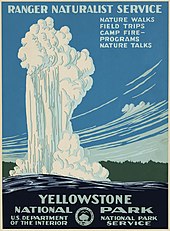
The United States has 63 national parks, which are congressionally designated protected areas operated by the National Park Service, an agency of the Department of the Interior.[1] National parks are designated for their natural beauty, unique geological features, diverse ecosystems, and recreational opportunities, typically "because of some outstanding scenic feature or natural phenomena."[2] While legislatively all units of the National Park System are considered equal with the same mission, national parks are generally larger and more of a destination, and hunting and extractive activities are prohibited.[3] National monuments, on the other hand, are also frequently protected for their historical or archaeological significance. Eight national parks (including six in Alaska) are paired with a national preserve, areas with different levels of protection that are administered together but considered separate units and whose areas are not included in the figures below. The 431 units of the National Park System can be broadly referred to as national parks, but most have other formal designations.[4]
A bill creating the first national park, Yellowstone, was signed into law by President Ulysses S. Grant in 1872, followed by Mackinac National Park in 1875 (decommissioned in 1895), and then Rock Creek Park (later merged into National Capital Parks), Sequoia and Yosemite in 1890. The Organic Act of 1916 created the National Park Service "to conserve the scenery and the natural and historic objects and wildlife therein, and to provide for the enjoyment of the same in such manner and by such means as will leave them unimpaired for the enjoyment of future generations."[5] Many current national parks had been previously protected as national monuments by the president under the Antiquities Act or as other designations created by Congress before being redesignated by Congress; the newest national park is New River Gorge, previously a National River, and the most recent entirely new park is National Park of American Samoa. A few former national parks are no longer designated as such, or have been disbanded. Fourteen national parks are designated UNESCO World Heritage Sites (WHS),[6] and 21 national parks are named UNESCO Biosphere Reserves (BR),[7] with eight national parks in both programs.
Thirty states have national parks, as do the territories of American Samoa and the U.S. Virgin Islands. The state with the most national parks is California with nine, followed by Alaska with eight, Utah with five, and Colorado with four. The largest national park is Wrangell–St. Elias in Alaska: at over 8 million acres (32,375 km2), it is larger than each of the nine smallest states. The next three largest parks are also in Alaska. The smallest park is Gateway Arch National Park, Missouri, at 192.83 acres (0.7804 km2). The total area protected by national parks is approximately 52.4 million acres (212,000 km2), for an average of 833 thousand acres (3,370 km2) but a median of only 220 thousand acres (890 km2).[8]
The national parks set a visitation record in 2021, with more than 92 million visitors.[9] Great Smoky Mountains National Park in North Carolina and Tennessee has been the most-visited park since 1944,[10] and had almost 13 million visitors in 2022.[11] In contrast, only about 9,500 people visited the remote Gates of the Arctic National Park and Preserve in Alaska in 2022.[11]
National parks
[edit]Summary
[edit]- Legend
- * Green – UNESCO designated World Heritage Sites (WHS)
- † Blue – UNESCO designated Biosphere Reserves(BR)
- ‡ Purple – parks designated in both UNESCO programs
| Name | Location | Date established as park[12] | Area (2023)[8] | Recreation visitors (2022)[11] |
|---|---|---|---|---|
| Acadia | Maine 44°21′N 68°13′W / 44.35°N 68.21°W |
February 26, 1919 | 49,071.40 acres (198.6 km2) | 3,970,260 |
| American Samoa | American Samoa 14°15′S 170°41′W / 14.25°S 170.68°W |
October 31, 1988 | 8,256.67 acres (33.4 km2) | 12,135 |
| Arches | Utah 38°41′N 109°34′W / 38.68°N 109.57°W |
November 12, 1971 | 76,678.98 acres (310.3 km2) | 1,460,652 |
| Badlands | South Dakota 43°45′N 102°30′W / 43.75°N 102.50°W |
November 10, 1978 | 242,755.94 acres (982.4 km2) | 1,006,809 |
| Big Bend † | Texas 29°15′N 103°15′W / 29.25°N 103.25°W |
June 12, 1944 | 801,163.21 acres (3,242.2 km2) | 514,107 |
| Biscayne | Florida 25°39′N 80°05′W / 25.65°N 80.08°W |
June 28, 1980 | 172,971.11 acres (700.0 km2) | 701,023 |
| Black Canyon of the Gunnison | Colorado 38°34′N 107°43′W / 38.57°N 107.72°W |
October 21, 1999 | 30,779.83 acres (124.6 km2) | 297,257 |
| Bryce Canyon | Utah 37°34′N 112°11′W / 37.57°N 112.18°W |
February 25, 1928 | 35,835.08 acres (145.0 km2) | 2,354,660 |
| Canyonlands | Utah 38°12′N 109°56′W / 38.2°N 109.93°W |
September 12, 1964 | 337,597.83 acres (1,366.2 km2) | 779,147 |
| Capitol Reef | Utah 38°12′N 111°10′W / 38.20°N 111.17°W |
December 18, 1971 | 241,904.50 acres (979.0 km2) | 1,227,608 |
| Carlsbad Caverns * | New Mexico 32°10′N 104°26′W / 32.17°N 104.44°W |
May 14, 1930 | 46,766.45 acres (189.3 km2) | 390,932 |
| Channel Islands † | California 34°01′N 119°25′W / 34.01°N 119.42°W |
March 5, 1980 | 249,561.00 acres (1,009.9 km2) | 323,245 |
| Congaree † | South Carolina 33°47′N 80°47′W / 33.78°N 80.78°W |
November 10, 2003 | 26,692.60 acres (108.0 km2) | 204,522 |
| Crater Lake | Oregon 42°56′N 122°06′W / 42.94°N 122.1°W |
May 22, 1902 | 183,224.05 acres (741.5 km2) | 527,259 |
| Cuyahoga Valley | Ohio 41°14′N 81°33′W / 41.24°N 81.55°W |
October 11, 2000 | 32,571.89 acres (131.8 km2) | 2,913,312 |
| Death Valley † | California, Nevada 36°14′N 116°49′W / 36.24°N 116.82°W |
October 31, 1994 | 3,408,395.63 acres (13,793.3 km2) | 1,128,862 |
| Denali † | Alaska 63°20′N 150°30′W / 63.33°N 150.50°W |
February 26, 1917 | 4,740,911.16 acres (19,185.8 km2) | 427,562 |
| Dry Tortugas † | Florida 24°38′N 82°52′W / 24.63°N 82.87°W |
October 26, 1992 | 64,701.22 acres (261.8 km2) | 78,488 |
| Everglades ‡ | Florida 25°19′N 80°56′W / 25.32°N 80.93°W |
May 30, 1934 | 1,508,938.57 acres (6,106.5 km2) | 1,155,193
(BR)[13] |
| Gates of the Arctic | Alaska 67°47′N 153°18′W / 67.78°N 153.30°W |
December 2, 1980 | 7,523,897.45 acres (30,448.1 km2) | 9,457 |
| Gateway Arch | Missouri 38°38′N 90°11′W / 38.63°N 90.19°W |
February 22, 2018[14] | 192.83 acres (0.8 km2) | 1,618,774 |
| Glacier ‡ | Montana 48°48′N 114°00′W / 48.80°N 114.00°W |
May 11, 1910 | 1,013,126.39 acres (4,100.0 km2) | 2,908,458 |
| Glacier Bay ‡ | Alaska 58°30′N 137°00′W / 58.50°N 137.00°W |
December 2, 1980 | 3,223,383.43 acres (13,044.6 km2) | 545,758 |
| Grand Canyon * | Arizona 36°04′N 112°08′W / 36.06°N 112.14°W |
February 26, 1919 | 1,201,647.03 acres (4,862.9 km2) | 4,732,101 |
| Grand Teton † | Wyoming 43°44′N 110°48′W / 43.73°N 110.80°W |
February 26, 1929 | 310,044.36 acres (1,254.7 km2) | 2,806,223
(BR)[7] |
| Great Basin | Nevada 38°59′N 114°18′W / 38.98°N 114.30°W |
October 27, 1986 | 77,180.00 acres (312.3 km2) | 142,115 |
| Great Sand Dunes | Colorado 37°44′N 105°31′W / 37.73°N 105.51°W |
September 24, 2004 | 107,345.73 acres (434.4 km2) | 493,428 |
| Great Smoky Mountains ‡ | North Carolina, Tennessee 35°41′N 83°32′W / 35.68°N 83.53°W |
June 15, 1934 | 522,426.88 acres (2,114.2 km2) | 12,937,633 |
| Guadalupe Mountains | Texas 31°55′N 104°52′W / 31.92°N 104.87°W |
September 30, 1972 | 86,367.10 acres (349.5 km2) | 219,987 |
| Haleakalā † | Hawaii 20°43′N 156°10′W / 20.72°N 156.17°W |
July 1, 1961 | 33,488.98 acres (135.5 km2) | 1,087,616 |
| Hawaiʻi Volcanoes ‡ | Hawaii 19°23′N 155°12′W / 19.38°N 155.20°W |
August 1, 1916 | 344,812.18 acres (1,395.4 km2) | 1,580,961
(BR)[15] |
| Hot Springs | Arkansas 34°31′N 93°03′W / 34.51°N 93.05°W |
March 4, 1921 | 5,554.15 acres (22.5 km2) | 2,646,133 |
| Indiana Dunes | Indiana 41°39′12″N 87°03′09″W / 41.6533°N 87.0524°W |
February 15, 2019 | 15,349.08 acres (62.1 km2) | 2,834,180 |
| Isle Royale † | Michigan 48°06′N 88°33′W / 48.10°N 88.55°W |
April 3, 1940 | 571,790.30 acres (2,314.0 km2) | 25,454 |
| Joshua Tree † | California 33°47′N 115°54′W / 33.79°N 115.90°W |
October 31, 1994 | 795,155.85 acres (3,217.9 km2) | 3,058,294
(BR)[16] |
| Katmai | Alaska 58°30′N 155°00′W / 58.50°N 155.00°W |
December 2, 1980 | 3,674,529.33 acres (14,870.3 km2) | 33,908 |
| Kenai Fjords | Alaska 59°55′N 149°39′W / 59.92°N 149.65°W |
December 2, 1980 | 669,650.05 acres (2,710.0 km2) | 389,943 |
| Kings Canyon † | California 36°48′N 118°33′W / 36.80°N 118.55°W |
March 4, 1940 | 461,901.20 acres (1,869.2 km2) | 640,986
(BR)[17] |
| Kobuk Valley | Alaska 67°33′N 159°17′W / 67.55°N 159.28°W |
December 2, 1980 | 1,750,716.16 acres (7,084.9 km2) | 16,925 |
| Lake Clark | Alaska 60°58′N 153°25′W / 60.97°N 153.42°W |
December 2, 1980 | 2,619,816.49 acres (10,602.0 km2) | 18,187 |
| Lassen Volcanic | California 40°29′N 121°31′W / 40.49°N 121.51°W |
August 9, 1916 | 106,589.02 acres (431.4 km2) | 446,291 |
| Mammoth Cave ‡ | Kentucky 37°11′N 86°06′W / 37.18°N 86.10°W |
July 1, 1941 | 72,472.87 acres (293.3 km2) | 663,147 |
| Mesa Verde * | Colorado 37°11′N 108°29′W / 37.18°N 108.49°W |
June 29, 1906 | 52,485.17 acres (212.4 km2) | 499,790 |
| Mount Rainier | Washington 46°51′N 121°45′W / 46.85°N 121.75°W |
March 2, 1899 | 236,381.64 acres (956.6 km2) | 1,622,395 |
| New River Gorge | West Virginia 38°04′N 81°05′W / 38.07°N 81.08°W |
December 27, 2020 | 7,021 acres (28.4 km2)[18] | 1,593,523 |
| North Cascades | Washington 48°42′N 121°12′W / 48.70°N 121.20°W |
October 2, 1968 | 504,780.94 acres (2,042.8 km2) | 30,154 |
| Olympic ‡ | Washington 47°58′N 123°30′W / 47.97°N 123.50°W |
June 29, 1938 | 922,649.41 acres (3,733.8 km2) | 2,432,972 |
| Petrified Forest | Arizona 35°04′N 109°47′W / 35.07°N 109.78°W |
December 9, 1962 | 221,390.21 acres (895.9 km2) | 505,209 |
| Pinnacles | California 36°29′N 121°10′W / 36.48°N 121.16°W |
January 10, 2013 | 26,685.73 acres (108.0 km2) | 275,023 |
| Redwood * | California 41°18′N 124°00′W / 41.30°N 124.00°W |
October 2, 1968 | 138,999.37 acres (562.5 km2) | 458,400 |
| Rocky Mountain † | Colorado 40°24′N 105°35′W / 40.40°N 105.58°W |
January 26, 1915 | 265,847.74 acres (1,075.8 km2) | 4,300,424 |
| Saguaro | Arizona 32°15′N 110°30′W / 32.25°N 110.50°W |
October 14, 1994 | 92,876.75 acres (375.9 km2) | 908,194 |
| Sequoia † | California 36°26′N 118°41′W / 36.43°N 118.68°W |
September 25, 1890 | 404,062.63 acres (1,635.2 km2) | 1,153,198 |
| Shenandoah | Virginia 38°32′N 78°21′W / 38.53°N 78.35°W |
December 26, 1935 | 200,445.92 acres (811.2 km2) | 1,449,300 |
| Theodore Roosevelt | North Dakota 46°58′N 103°27′W / 46.97°N 103.45°W |
November 10, 1978 | 70,446.89 acres (285.1 km2) | 668,679 |
| Virgin Islands | U.S. Virgin Islands 18°20′N 64°44′W / 18.33°N 64.73°W |
August 2, 1956 | 15,052.33 acres (60.9 km2) | 196,752 |
| Voyageurs | Minnesota 48°30′N 92°53′W / 48.50°N 92.88°W |
April 8, 1975 | 218,222.35 acres (883.1 km2) | 221,434 |
| White Sands | New Mexico 32°47′N 106°10′W / 32.78°N 106.17°W |
December 20, 2019[19] | 146,344.31 acres (592.2 km2) | 705,127 |
| Wind Cave | South Dakota 43°34′N 103°29′W / 43.57°N 103.48°W |
January 9, 1903 | 33,970.84 acres (137.5 km2) | 607,418 |
| Wrangell–St. Elias * | Alaska 61°00′N 142°00′W / 61.00°N 142.00°W |
December 2, 1980 | 8,323,146.48 acres (33,682.6 km2) | 65,236 |
| Yellowstone ‡ | Wyoming, Montana, Idaho 44°36′N 110°30′W / 44.60°N 110.50°W |
March 1, 1872 | 2,219,790.71 acres (8,983.2 km2) | 3,290,242 |
| Yosemite * | California 37°50′N 119°30′W / 37.83°N 119.50°W |
October 1, 1890 | 761,747.50 acres (3,082.7 km2) | 3,667,550 |
| Zion | Utah 37°18′N 113°03′W / 37.30°N 113.05°W |
November 19, 1919 | 147,242.66 acres (595.9 km2) | 4,692,417 |
Acadia National Park
[edit]
Covering most of Mount Desert Island and other coastal islands, Acadia features the tallest mountain on the Atlantic coast of the United States, granite peaks, ocean shoreline, woodlands, and lakes. There are freshwater, estuary, forest, and intertidal habitats.[20][21]
National Park of American Samoa
[edit]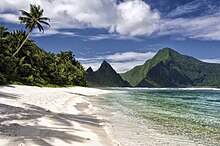
The southernmost national park is on three Samoan islands in the South Pacific. It protects coral reefs, rainforests, volcanic mountains, and white beaches. The area is also home to flying foxes, brown boobies, sea turtles, and 900 species of fish.[22]
Arches National Park
[edit]
This site features more than 2,000 natural sandstone arches, with some of the most popular arches in the park being Delicate Arch, Landscape Arch and Double Arch.[23] Millions of years of erosion have created these structures in a desert climate where the arid ground has life-sustaining biological soil crusts and potholes that serve as natural water-collecting basins. Other geologic formations include stone pinnacles, fins, and balancing rocks.[24]
Badlands National Park
[edit]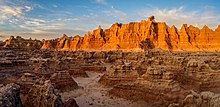
The Badlands are a collection of buttes, pinnacles, spires, and mixed-grass prairies within the drainage basin of the White River, in southwestern South Dakota. They contain the largest known assemblage of late Eocene and Oligocene mammal fossils.[25] Wildlife includes bison, bighorn sheep, black-footed ferrets, and prairie dogs.[26]
Biscayne National Park
[edit]
The central part of Biscayne Bay, this mostly underwater park at the north end of the Florida Keys has four interrelated marine ecosystems: mangrove forest, the Bay, the Keys, and coral reefs. Threatened animals include the West Indian manatee, American crocodile, various sea turtles, and the peregrine falcon.[27]
Black Canyon of the Gunnison National Park
[edit]
The park protects a quarter of the Gunnison River, which slices sheer canyon walls from dark Precambrian-era rock. The canyon features some of the steepest cliffs and oldest rock in North America, and is a popular site for river rafting and rock climbing. The deep, narrow canyon is composed of gneiss and schist, which appears black when in shadow.[28]
Bryce Canyon National Park
[edit]
Bryce Canyon is a geological amphitheater on southern Utah's Paunsaugunt Plateau with hundreds of tall, multicolored sandstone hoodoos formed by erosion. The region was originally settled by Native Americans and later by Mormon pioneers.[29]
Canyonlands National Park
[edit]
This landscape was eroded into a maze of canyons, buttes, and mesas by the combined efforts of the Colorado River, Green River, and their tributaries, which divide the park into three districts. The park contains thousands of rock pinnacles and arches, as well as artifacts from Ancient Pueblo peoples.[30]
Capitol Reef National Park
[edit]
The park's Waterpocket Fold is a 100-mile (160 km) monocline that exhibits the earth's diverse geologic layers. Other natural features include monoliths, eroded buttes, and sandstone domes, including one shaped like the United States Capitol.[31]
Crater Lake National Park
[edit]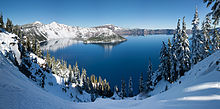
Crater Lake lies in the caldera of an ancient volcano called Mount Mazama that collapsed 7,700 years ago. The lake is the deepest in the United States and is noted for its vivid blue color and water clarity. Wizard Island and the Phantom Ship are more recent volcanic formations within the caldera. As the lake has no inlets or outlets, it is replenished only by precipitation.[32]
Cuyahoga Valley National Park
[edit]
This park along the Cuyahoga River has waterfalls, hills, trails, and exhibits on early rural living. The Ohio and Erie Canal Towpath Trail follows the Ohio and Erie Canal, where mules towed canal boats. The park has numerous historic homes, bridges, and structures,[33] and also offers a scenic train ride.[34]
Gates of the Arctic National Park and Preserve
[edit]
The country's northernmost park protects an expanse of pure wilderness in Alaska's Brooks Range and has no park facilities. The land is home to Alaska Natives who have relied on the land and caribou for 11,000 years.[35]
Gateway Arch National Park
[edit]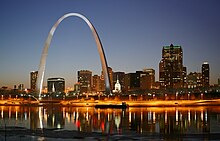
The Gateway Arch is a 630-foot (192 m) (both high and wide) catenary arch built in the 1960s to commemorate the Lewis and Clark Expedition, initiated by Thomas Jefferson, and the subsequent westward expansion of the country. The nearby Old Courthouse, across a greenway to the west of the arch, was the original site of the landmark Dred Scott case about slavery. An underground museum describes the arch's construction and the country's westward expansion.[36]
Great Basin National Park
[edit]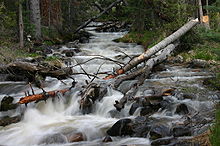
Based around Nevada's second tallest mountain, Wheeler Peak, Great Basin National Park protects 5,000-year-old bristlecone pines, a rock glacier, and the limestone Lehman Caves. Due to its remote location, the park is home to some of the country's darkest night skies. Wildlife includes the Townsend's big-eared bat, pronghorn, and Bonneville cutthroat trout.[37]
Great Sand Dunes National Park and Preserve
[edit]
The tallest sand dunes in North America, up to 750 feet (230 m) tall, were formed by deposits of the ancient Rio Grande in the San Luis Valley. Abutting a variety of grasslands, shrublands, and wetlands, the park also features alpine lakes, six 13,000-foot mountains, and old-growth forests.[38]
Guadalupe Mountains National Park
[edit]
This park contains Guadalupe Peak, the highest point in Texas, as well as the scenic McKittrick Canyon filled with bigtooth maples, a corner of the arid Chihuahuan Desert, and a fossilized coral reef from the Permian era.[39]
Hot Springs National Park
[edit]
Hot Springs was originally established by Congress as a federal reserve on April 20, 1832, making it the oldest area managed by the National Park Service. Natural thermal springs flow out of the Ouachita Mountains, providing opportunities for relaxation in a historic setting. Bathhouse Row preserves examples of 19th-century architecture.[40] Hot Springs is the first national park within a city and was the smallest national park until 2018.[41]
Indiana Dunes National Park
[edit]
Previously designated a national lakeshore, parts of this 20-mile (32 km) stretch of the southern shore of Lake Michigan have sandy beaches and tall dunes. The park includes grassy prairies, peat bogs, and marsh wetlands home to over 2,000 species.[42]
Katmai National Park and Preserve
[edit]
This park on the Alaska Peninsula protects the Valley of Ten Thousand Smokes, an ash flow formed by the 1912 eruption of Novarupta, and the stratovolcano Mount Katmai. Over 2,000 grizzly bears come here each year to catch spawning salmon. Other wildlife includes caribou, wolves, moose, and wolverines.[43]
Kenai Fjords National Park
[edit]
Near Seward on the Kenai Peninsula, this park protects the Harding Icefield and at least 38 glaciers and fjords stemming from it. The only area accessible to the public by road is the rapidly shrinking Exit Glacier. Boat and kayak tours offer views of tidewater glaciers, whales, sea lions, and marine birds.[44]
Kobuk Valley National Park
[edit]
Kobuk Valley protects 61 miles (98 km) of the Kobuk River and three regions of sand dunes. Created by glaciers, the Great Kobuk, Little Kobuk, and Hunt River Sand Dunes can reach 100 feet (30 m) high and 100 °F (38 °C), and they are the largest dunes in the Arctic. Twice a year, half a million caribou migrate through the dunes and across river bluffs that expose well-preserved ice age fossils.[45]
Lake Clark National Park and Preserve
[edit]
The region around Lake Clark features four active volcanoes, including Mount Redoubt, as well as an abundance of rivers, glaciers, and waterfalls. Temperate rainforests, a tundra plateau, and three mountain ranges complete the landscape.[46]
Lassen Volcanic National Park
[edit]
Lassen Peak, the largest lava dome volcano in the world, is joined by all three other types of volcanoes in this park: shield, cinder cone, and composite. Though Lassen itself last erupted in 1915, most of the rest of the park is continuously active. Numerous hydrothermal features, including fumaroles, boiling pools, and bubbling mud pots, are heated by molten rock from beneath the peak.[47]
Mount Rainier National Park
[edit]
Mount Rainier, an active stratovolcano, is the most prominent peak in the Cascades and is covered by 26 named glaciers including Carbon Glacier and Emmons Glacier, the longest and largest in the contiguous United States respectively. The mountain is popular for climbing, and more than half of the park is covered by subalpine and alpine forests and meadows seasonally in bloom with wildflowers. Paradise on the south slope is among the snowiest places on Earth.[48] The Longmire visitor center is the start of the Wonderland Trail, which encircles the mountain.[49]
New River Gorge National Park and Preserve
[edit]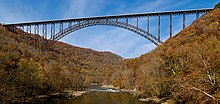
The New River Gorge is the deepest river gorge east of the Mississippi River. The park primarily covers the lower gorge area around the New River Gorge Bridge, which features some of the country's best whitewater rafting. Smaller noncontiguous sections showcase the ghost town of Thurmond, the scenic Grandview vista, and Sandstone Falls. The other 65,165 acres (263.71 km2) of the redesignated national river is now a national preserve, spanning 53 mi (85 km) of the New River.[50][51]
North Cascades National Park
[edit]
The highly glaciated mountains of the North Cascades Range exhibit a spectacular and complex geologic history. Between the river valleys and high peaks there are eight diverse life zones with 75 mammal and 1,600 vascular plant species. Popular hiking and climbing areas of the Stephen Mather Wilderness include Cascade Pass, Mount Shuksan, Mount Triumph, and Eldorado Peak. Ross Lake and Lake Chelan National Recreation Areas adjoin the two segments of the park and are all administered together.[52]
Petrified Forest National Park
[edit]
This portion of the Chinle Formation has a large concentration of 225-million-year-old petrified wood. The surrounding Painted Desert features eroded cliffs of red-hued volcanic rock called bentonite. Dinosaur fossils and over 350 Native American sites are also protected in this park.[53]
Saguaro National Park
[edit]
Split into the separate Rincon Mountain and Tucson Mountain districts, this park is evidence that the dry Sonoran Desert is still home to a great variety of life spanning six biotic communities. Beyond the namesake giant saguaro cacti, there are barrel cacti, chollas, and prickly pears, as well as lesser long-nosed bats, spotted owls, and javelinas.[54]
Shenandoah National Park
[edit]
Shenandoah's Blue Ridge Mountains are covered by hardwood forests that teem with a wide variety of wildlife. The Skyline Drive and Appalachian Trail run the entire length of this narrow park, along with more than 500 miles (800 km) of hiking trails passing scenic overlooks and cataracts of the Shenandoah River.[55]
Theodore Roosevelt National Park
[edit]
This region that enticed and influenced President Theodore Roosevelt consists of a park of three units in the northern badlands. Besides Roosevelt's historic cabin, there are numerous scenic drives and backcountry hiking opportunities. Wildlife includes American bison, pronghorn, bighorn sheep, and wild horses.[56]
Virgin Islands National Park
[edit]
This island park on Saint John preserves pristine beaches surrounded by mangrove forests, seagrass beds, and coral reefs. It also has Taíno archaeological sites and the ruins of sugar plantations from Columbus's time.[57]
Voyageurs National Park
[edit]
This park protecting four lakes near the Canada–US border is a site for canoeing, kayaking, and fishing. The park also preserves a history populated by Ojibwe Native Americans, French fur traders called voyageurs, and gold miners. Formed by glaciers, the region features tall bluffs, rock gardens, islands, bays, and several historic buildings.[58]
Wind Cave National Park
[edit]
Wind Cave is distinctive for its calcite fin formations called boxwork, a unique formation rarely found elsewhere, and needle-like growths called frostwork. It is one of the longest caves in the world and creates a wind as air pressure changes. Above ground is a mixed-grass prairie with animals such as bison, black-footed ferrets, and prairie dogs and ponderosa pine forests home to cougars and elk.[59] The cave is culturally significant to the Lakota people as a creation site.[60]
Zion National Park
[edit]
Located at the junction of the Colorado Plateau, Great Basin, and Mojave Desert, this park contains sandstone features such as mesas, rock towers, and canyons, including the Virgin River Narrows. The various sandstone formations and the forks of the Virgin River create a wilderness divided into four ecosystems: desert, riparian, woodland, and coniferous forest.[61]
Parks by state or territory
[edit]The following table includes the 30 states and two territories that have national parks. Exclusive parks refer to parks entirely within one state or territory. Shared parks refer to parks in multiple states.
Territories are set in italics.
| State | Total parks | Exclusive parks | Shared parks |
|---|---|---|---|
| California | 9 | 8 | 1 |
| Alaska | 8 | 8 | — |
| Utah | 5 | 5 | — |
| Colorado | 4 | 4 | — |
| Arizona | 3 | 3 | — |
| Florida | 3 | 3 | — |
| Washington | 3 | 3 | — |
| Hawaii | 2 | 2 | — |
| New Mexico | 2 | 2 | — |
| South Dakota | 2 | 2 | — |
| Texas | 2 | 2 | — |
| Montana | 2 | 1 | 1 |
| Nevada | 2 | 1 | 1 |
| Wyoming | 2 | 1 | 1 |
| American Samoa | 1 | 1 | — |
| Arkansas | 1 | 1 | — |
| Indiana | 1 | 1 | — |
| Kentucky | 1 | 1 | — |
| Maine | 1 | 1 | — |
| Michigan | 1 | 1 | — |
| Minnesota | 1 | 1 | — |
| Missouri | 1 | 1 | — |
| North Dakota | 1 | 1 | — |
| Ohio | 1 | 1 | — |
| Oregon | 1 | 1 | — |
| South Carolina | 1 | 1 | — |
| U.S. Virgin Islands | 1 | 1 | — |
| Virginia | 1 | 1 | — |
| West Virginia | 1 | 1 | — |
| Idaho | 1 | — | 1 |
| North Carolina | 1 | — | 1 |
| Tennessee | 1 | — | 1 |
See also
[edit]- National Park Service
- History of the National Park Service
- List of areas in the United States National Park System
- List of the United States National Park System official units
- List of national monuments of the United States
- List of National Wildlife Refuges of the United States
- List of U.S. National Forests
- Lists of state parks by U.S. state
- List of World Heritage Sites in the United States
References
[edit]- ^ "National Park System (U.S. National Park Service)". March 15, 2018.
- ^ Yard, Robert Sterling (1931). "Difference Between a National Park and a National Monument". The National Parks Portfolio.
- ^ Sachs, Andrea (August 24, 2016). "What does the National Park Service consider a national park?". The Washington Post.
- ^ "Lower, Rocío (October 17, 2016). "How many national parks are there?". nationalparks.org. National Park Foundation. Archived from the original on February 22, 2017. Retrieved February 24, 2017.
The National Park System encompasses 417 national parks in the United States.... Within the system, 59 sites include 'National Park' as part of their proper name
- ^ "NPS Organic Act Overview". nature.nps.gov. National Park Service. January 17, 2007. Archived from the original on February 6, 2017. Retrieved February 26, 2017.
- ^ "World Heritage List - United States of America". whc.unesco.org. UNESCO World Heritage Centre. Archived from the original on February 25, 2017. Retrieved February 25, 2017.
- ^ a b "UNESCO » Biosphere Reserves » United States of America". unesco.org. UNESCO. November 2015. Archived from the original on February 22, 2017. Retrieved February 22, 2017.
- ^ a b "National Park Service Acreage Reports". nps.gov. National Park Service. March 31, 2023. Retrieved May 15, 2023.
"Gross Area Acres" data retrieved from "Listing of Acreage" sheet.
- ^ "Annual Visitation by Park Type or Region for: 2021 By Park Type". Irma.NPS.gov. Retrieved July 9, 2023.
- ^ "National Parks Hosted 237 Million Visitors in 2020 - Office of Communications (U.S. National Park Service)". www.nps.gov. Retrieved February 26, 2021.
- ^ a b c "Annual Park Ranking Report for Recreation Visits in: 2022". NPS Stats. National Park Service, U.S. Department of the Interior. Retrieved May 15, 2023.
- ^ "National Park System Areas Listed in Chronological Order of Date Authorized under DOI" (PDF). National Park Service. June 27, 2005. Archived from the original on March 11, 2012. Retrieved January 18, 2010.
{{cite web}}: CS1 maint: unfit URL (link) - ^ Cite error: The named reference
evdtwas invoked but never defined (see the help page). - ^ "President Donald J. Trump Signs S. 1438 into Law". whitehouse.gov. February 22, 2018. Archived from the original on January 20, 2021. Retrieved November 19, 2018 – via National Archives.
- ^ Cite error: The named reference
hawaiiwas invoked but never defined (see the help page). - ^ Cite error: The named reference
dvjtwas invoked but never defined (see the help page). - ^ Cite error: The named reference
sekcwas invoked but never defined (see the help page). - ^ "New River Gorge: America's newest national park is one of West Virginia's hidden gems". The Washington Post. Retrieved August 10, 2022.
- ^ "H.R.2500 - 116th Congress (2019-2020): National Defense Authorization Act for Fiscal Year 2020". www.congress.gov. Retrieved December 21, 2019.
Subtitle E--White Sands National Park and White Sands Missile Range, SEC. 2851...approximately 2,826 acres of land identified as "To NPS, lands inside current boundary" [plus] approximately 5,766 acres of land identified as "To NPS, new additions" [minus] approximately 3,737 acres of land identified as "To DOA".
- ^ "Acadia National Park". National Park Service. Retrieved March 23, 2010.
- ^ "Acadia National Park Places To Go". National Park Service. Retrieved January 28, 2014.
- ^ "National Park of American Samoa". National Park Service. Retrieved March 23, 2010.
- ^ "Arches National Park - Arches Rock Stars". National Park Service. Retrieved February 25, 2017.
- ^ "Arches National Park". National Park Service. Retrieved March 23, 2010.
- ^ "Badlands National Park - Fossils". National Park Service. Retrieved February 25, 2017.
- ^ "Badlands National Park". National Park Service. Retrieved March 23, 2010.
- ^ "Biscayne National Park". National Park Service. Retrieved March 23, 2010.
- ^ "Black Canyon of the Gunnison National Park". National Park Service. Retrieved March 23, 2010.
- ^ "Bryce Canyon National Park". National Park Service. Retrieved March 23, 2010.
- ^ "Canyonlands National Park". National Park Service. Retrieved March 23, 2010.
- ^ "Capitol Reef National Park". National Park Service. Retrieved March 23, 2010.
- ^ "Crater Lake National Park". National Park Service. Retrieved March 23, 2010.
- ^ "Cuyahoga Valley National Park". National Park Service. Retrieved March 23, 2010.
- ^ "Cuyahoga Valley National Park Scenic Railroad". National Park Service. Retrieved November 4, 2012.
- ^ "Gates of the Arctic National Park". National Park Service. Retrieved March 23, 2010.
- ^ "Gateway Arch National Park". National Park Service. Retrieved February 23, 2018.
- ^ "Great Basin National Park". National Park Service. Retrieved March 23, 2010.
- ^ "Great Sand Dunes National Park". National Park Service. Retrieved March 23, 2010.
- ^ "Guadalupe Mountains National Park". National Park Service. Retrieved March 23, 2010.
- ^ "Hot Springs National Park". National Park Service. Retrieved March 23, 2010.
- ^ "President Donald J. Trump Signs S. 1438 into Law". whitehouse.gov – via National Archives.
- ^ "Indiana Dunes National Park". National Park Service. Retrieved February 16, 2019.
- ^ "Katmai National Park". National Park Service. Retrieved March 23, 2010.
- ^ "Kenai Fjords National Park". National Park Service. Retrieved March 23, 2010.
- ^ "Kobuk Valley National Park". National Park Service. Retrieved March 23, 2010.
- ^ "Lake Clark National Park". National Park Service. Retrieved March 23, 2010.
- ^ "Lassen Volcanic National Park". National Park Service. Retrieved March 23, 2010.
- ^ "Mount Rainier National Park – Frequently Asked Questions". National Park Service. Retrieved February 28, 2017.
- ^ "Mount Rainier National Park". National Park Service. Retrieved March 23, 2010.
- ^ "New River Gorge National Park and Preserve". National Park Service. Retrieved December 27, 2020.
- ^ Averill, Graham (December 22, 2020). "West Virginia's New River Gorge Will Be Our 63rd National Park". Outside Online. Retrieved December 28, 2020.
- ^ "North Cascades National Park". National Park Service. Retrieved March 23, 2010.
- ^ "Petrified Forest National Park". National Park Service. Retrieved March 23, 2010.
- ^ "Saguaro National Park". National Park Service. Retrieved March 23, 2010.
- ^ "Shenandoah National Park". National Park Service. Retrieved March 23, 2010.
- ^ "Theodore Roosevelt National Park". National Park Service. Retrieved March 23, 2010.
- ^ "Virgin Islands National Park". National Park Service. Retrieved March 23, 2010.
- ^ "Voyageurs National Park". National Park Service. Retrieved March 23, 2010.
- ^ "Wind Cave National Park". National Park Service. Retrieved March 23, 2010.
- ^ "Wind Cave's Early Days". National Park Service. Retrieved February 28, 2017.
- ^ "Zion National Park". National Park Service. Retrieved March 23, 2010.
External links
[edit]- Official website of the National Park Service (NPS)
- Find a park (NPS)
- Visitor use statistics (NPS)
- The National Parks: America's Best Idea by PBS
- America's Natural Heritage - The Essential Guide to the National Parks by The Washington Post
- List of National Parks by State


